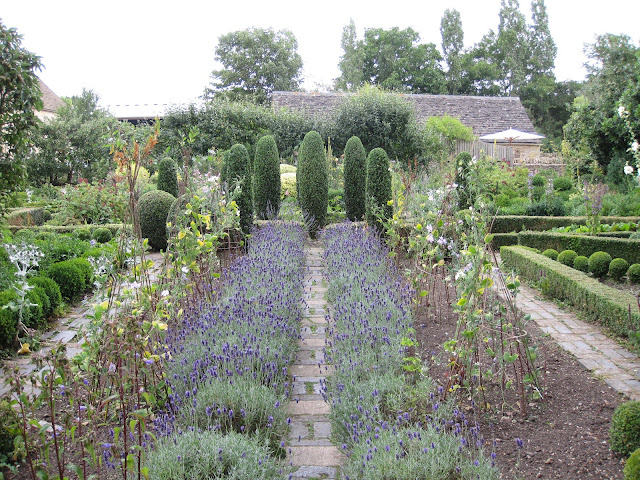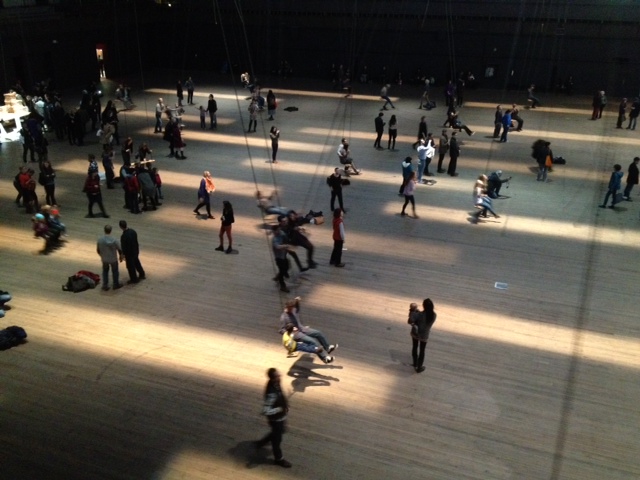the event of a thread
ANN HAMILTON
The Park Avenue Armory
December 8, 2012 - January 6, 2013
Until yesterday, the last time I was on a swing, my mother was dying. She wanted to take my nephew to a playground in a local park near our home. She watched; we swung.
Ann Hamilton's public art piece,
the event of a thread, in the Wade Thompson Drill Hall at the Park Avenue Armory consumes all 55,000 square feet of the hall. Divided in two parts by a white silk curtain, whose movement is determined by a series of rope-and-pulleys attached to the 42 swings suspended by chains from the ceiling; everyone who enters has a chance to swing.
Before entering the space, I went to a talk given by Ann Hamilton and Kristy Edmunds, Armory Artistic Director. Ann began by talking about her earliest memories of being read to. The intimacy of the reader's voice, the rhythm of the voice, the faraway world of the story and tenderness of being tucked into her grandmother's body. Hamilton called this memory a sequence of recognitions.

"the event of a thread is made of many crossings of the
near at hand and the far away: it is a body crossing space, is a writer’s hand
crossing a sheet of paper, is a voice crossing a room in a paper bag, is a
reader crossing with a page and with another reader, is listening crossing with
speaking, is an inscription crossing a transmission, is a stylus crossing a
groove, is a song crossing species, is the weightlessness of suspension
crossing the calling of bell or bellows, is touch being touched in return. It
is a flock of birds and a field of swings in motion. It is a particular point
in space at an instant of time." Ann Hamilton
Hamilton explores the question: What are the experiences that allow us to pay attention? This is a question that plagues me and which I continually struggle to answer in my own work.
"If on a swing, we are alone, we are together in a field. This condition of the social is the event of a thread. Our crossing with its motions, sounds, and textures is its weaving; is a social act." Hamilton
the event of a thread* is a gift to the people of New York. On Saturday, everyone from babies in front packs to those being helped onto the swings with their canes had a smile on their face. Some people went high, some barely let their feet off the ground, some gravitated to the impromptu row of bodies under the cloth, some walked to the writers or readers that are part of the piece, others just stared at the pigeons in their cages. In her review of Hamilton's piece in The New York Times, Roberta Smith said she didn't know whether this was ART. It really doesn't matter. It's an expression of pure happiness. As Hamilton said "it might be close to "Heaven."
*Anni Albers, in writing for Encylcopedia Brittanica, wrote that all weaving traces back to "the event of a thread."
________________________________________
Whenever I think of swinging, I am always reminded of the Robert Frost poem, Birches.
Birches
BY ROBERT FROST
When I see birches bend to left and right
Across the lines of straighter darker trees,
I like to think some boy's been swinging them.
But swinging doesn't bend them down to stay
As ice-storms do. Often you must have seen them
Loaded with ice a sunny winter morning
After a rain. They click upon themselves
As the breeze rises, and turn many-colored
As the stir cracks and crazes their enamel.
Soon the sun's warmth makes them shed crystal shells
Shattering and avalanching on the snow-crust—
Such heaps of broken glass to sweep away
You'd think the inner dome of heaven had fallen.
They are dragged to the withered bracken by the load,
And they seem not to break; though once they are bowed
So low for long, they never right themselves:
You may see their trunks arching in the woods
Years afterwards, trailing their leaves on the ground
Like girls on hands and knees that throw their hair
Before them over their heads to dry in the sun.
But I was going to say when Truth broke in
With all her matter-of-fact about the ice-storm
I should prefer to have some boy bend them
As he went out and in to fetch the cows—
Some boy too far from town to learn baseball,
Whose only play was what he found himself,
Summer or winter, and could play alone.
One by one he subdued his father's trees
By riding them down over and over again
Until he took the stiffness out of them,
And not one but hung limp, not one was left
For him to conquer. He learned all there was
To learn about not launching out too soon
And so not carrying the tree away
Clear to the ground. He always kept his poise
To the top branches, climbing carefully
With the same pains you use to fill a cup
Up to the brim, and even above the brim.
Then he flung outward, feet first, with a swish,
Kicking his way down through the air to the ground.
So was I once myself a swinger of birches.
And so I dream of going back to be.
It's when I'm weary of considerations,
And life is too much like a pathless wood
Where your face burns and tickles with the cobwebs
Broken across it, and one eye is weeping
From a twig's having lashed across it open.
I'd like to get away from earth awhile
And then come back to it and begin over.
May no fate willfully misunderstand me
And half grant what I wish and snatch me away
Not to return. Earth's the right place for love:
I don't know where it's likely to go better.
I'd like to go by climbing a birch tree,
And climb black branches up a snow-white trunk
Toward heaven, till the tree could bear no more,
But dipped its top and set me down again.
That would be good both going and coming back.
One could do worse than be a swinger of birches.



















 snap du jour (photo blog)
snap du jour (photo blog)




